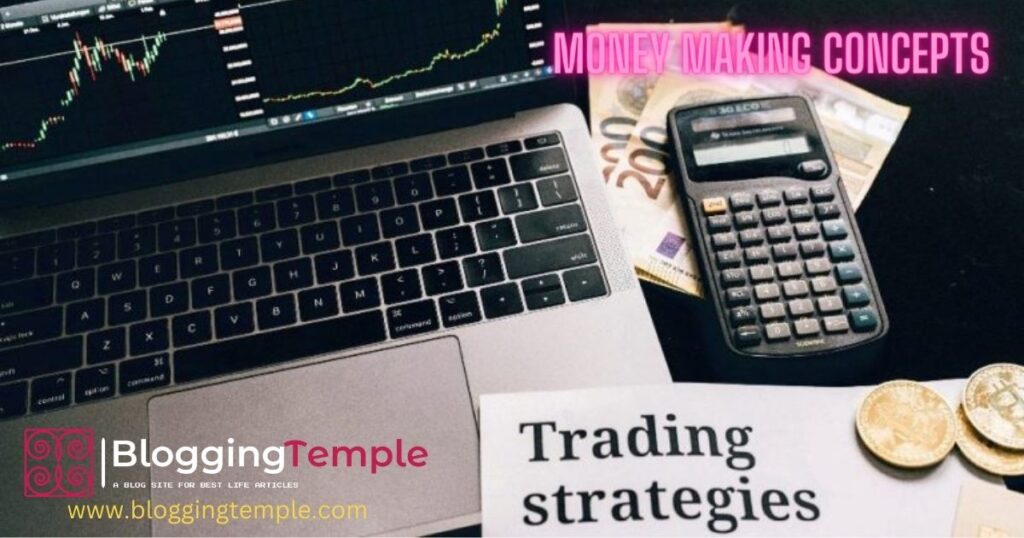Trading has developed as a dynamic and possibly lucrative activity in the fast-paced world of finance. It entails trading in a range of financial products, including stocks, commodities, currencies, and more. This thorough guide will bring you through the fundamentals, tactics, and difficulties of It, regardless matter whether you are an experienced investor or a novice to the world.
Table of Contents
Introduction
Trading is the practice of taking advantage of market fluctuations by purchasing assets below market value and then selling them at a profit. A variety of financial markets are involved in this dynamic industry, each with specific risks and characteristics. Understanding the fundamentals is essential whether you’re interested in stocks, currency, commodities, or cryptocurrencies.

Key Principles of Trading
Several fundamental ideas serve as the cornerstone of successful trading. A key idea is the risk and reward ratio, which compares prospective gains and losses. Traders use a variety of market analysis approaches, such as technical and fundamental analysis, to make well-informed decisions. Discipline, on the other hand, continues to be the cornerstone of a trader’s success, enabling them to keep to their plans even amid turbulence.
Types of Trading
Traders have a variety of its strategies to select from, depending on their interests and risk tolerance. Day trading entails carrying out several trades in a single day with the goal of making money off of swift price changes. Swing trading, on the other hand, keeps trades open for a number of days in order to take advantage of larger price fluctuations. Targeting long-term market patterns requires position trading, with deals spanning weeks or months.
Building Your Strategy
To consistently succeed in trading, a strong strategy must be developed. Start by establishing precise objectives, such as earning a certain sum of money or mastering a new skill. Pick marketplaces that fit your hobbies and areas of competence. You can make wise selections by using technical and fundamental studies, which offer perceptions into market patterns and asset prices.
Technical Analysis
The goal of technical analysis is to predict future price movements by analyzing historical price data. To spot trends and probable reversals, traders utilize oscillators, indicators, and chart patterns. Candlestick patterns help traders time their inputs and exits by providing useful insights into market sentiment.

Fundamental Analysis
Through the research of economic data, financial reports, and outside events, fundamental analysis seeks to determine an asset’s underlying value. Market sentiment is affected by economic data like GDP growth and unemployment rates. While news and events have the potential to cause substantial market movements, earnings releases provide information about a company’s financial health.
Risk Management
In trading, effective risk management is crucial. To prevent potential losses and ensure profits, set stop-loss and take-profit thresholds. Increase portfolio diversification to distribute risk among various assets. Recognize that leverage can increase both profits and losses.
Executing Trades
Making crucial choices while placing orders, such as whether to use market orders for immediate execution or limit orders to purchase or sell at a set price, is necessary. When managing open positions, you must be vigilant, keeping an eye on market conditions and modifying your plan of action as necessary.
Psychology of Trading
The hardest part of trading may be managing one’s emotions. Fear and greed can impair reason and cause rash actions. Keeping a notebook will help you keep track of your feelings, learn from your errors, and gradually improve your technique.
Common Mistakes to Avoid
A trader’s success may be hampered by a number of traps. Trading rashly to try and recover losses while chasing losses rarely works out successfully. Losses might also result by trading against the trend or ignoring it. Other common mistakes include doing too little research and making impulsive trades.
Adapting to Market Changes
Markets move through many periods and are dynamic. While prices rise in bull markets, prices fall for an extended period of time in bear markets. Market hesitancy is indicated by sideways trends. Rapid price fluctuations can result from volatile conditions, which are frequently brought on by important occurrences.
Developing a Winning Mindset
A winning mindset is based on tolerance, tenacity, and ongoing education. Recognise that failure is a part of the game and that every failure teaches you something. Keep learning, hone your talents, and adjust to shifting market conditions.
Selecting a Platform
It’s crucial to pick the best trading platform. Real-time data, sophisticated graphing tools, and user-friendly interfaces are all desirable qualities. Accessibility makes it possible for you to monitor and complete trades even on the go, particularly through mobile apps.
Legal and Tax Implications
Legal and tax implications come with trading. Different marketplaces are governed by different laws, and getting expert guidance can help you deal with complicated legal issues.
Conclusion
Trading is a thrilling experience that presents both chances and difficulties. You may confidently traverse the complicated world of financial markets by grasping principles, mastering analysis techniques, and managing risks well.
FAQs (Frequently Asked Questions)
Ques:- What is trading?
Trading refers to the buying and selling of financial instruments such as stocks, bonds, commodities, and currencies in order to profit from price movements.
Ques:- Is trading suitable for beginners?
Trading can be challenging for beginners due to its complexities. However, with proper education and practice, beginners can gradually become proficient traders.
Ques:- What’s the difference between technical and fundamental analysis?
Technical analysis involves studying price charts and patterns, while fundamental analysis focuses on economic indicators
Ques:- What are financial instruments?
Financial instruments are assets that can be traded, representing a value or a contract between parties. Examples include stocks, bonds, options, futures, and currencies.
Ques:- How do I start trading?
To start trading, you need a brokerage account. Research different brokerage firms, open an account, deposit funds, and then you can place trades through their platform.
Ques:- What is a brokerage account?
A brokerage account is a specialized account that allows you to buy and sell financial instruments in the markets. Brokerages provide access to trading platforms and tools.
Ques:- What is the difference between a trader and an investor?
Traders aim to profit from short-term price movements and often make frequent trades, while investors focus on long-term growth and typically hold assets for extended periods.
Ques:- What is technical analysis?
Technical analysis involves analyzing historical price and volume data to predict future price movements. Traders use charts and indicators to make decisions.
Ques:- What is fundamental analysis?
Fundamental analysis involves evaluating a company’s financial health, economic indicators, and market trends to estimate the intrinsic value of an asset.
Ques:- What is leverage?
Leverage allows traders to control a larger position with a smaller amount of capital. It amplifies both gains and losses.
Ques:- What is a margin call?
A margin call occurs when a trader’s account balance falls below the required margin level. The trader is then required to deposit more funds to cover potential losses.
Ques:- What is a stop-loss order?
A stop-loss order is a pre-set instruction to sell an asset if its price reaches a certain level. It helps limit potential losses.
Ques:- What is a market order?
A market order is an instruction to buy or sell an asset at the current market price. It guarantees execution but not the exact price.
Ques:- What is a limit order?
A limit order is an instruction to buy or sell an asset at a specific price or better. It provides price control but may not guarantee execution.
Ques:- How much capital do I need to start trading?
The required capital varies based on the market, trading strategy, and risk tolerance. Some markets have lower barriers to entry than others.
Ques:- Is trading risky?
Yes, trading carries inherent risks due to market volatility. It’s possible to incur substantial losses, so it’s important to have a well-defined strategy and risk management.
Ques:- How can I manage risk while trading?
Risk management involves setting stop-loss levels, diversifying your trades, not risking more than a certain percentage of your capital on a single trade, and using appropriate position sizes.
Ques:- Can I trade part-time?
Yes, many traders start as part-timers. However, trading requires research, discipline, and continuous learning.
Ques:- Can I trade without any experience?
While it’s possible, it’s not advisable. Gaining a solid understanding of the markets and practicing with virtual accounts can help mitigate potential losses from lack of experience.
***You Can also Visit the Following Links***
Exploring The Benefits of Electric Vehicles
Best Electric Cars in the Market
How to Learn Digital Marketing
Learn SEO (Search Engine Optimization)
Earn Using Mobile Phones (Mobile Marketing)
Learn Social Media Marketing (SMM)
Best Work from Home Job Options
Understanding Mutual Funds | Beginner’s Guide
New Way in 2023 to Invest in DYNAMIC MUTUAL FUNDS | Best Fundraising Policies

